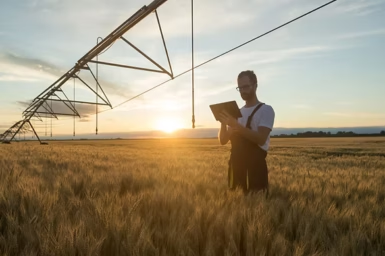RiskWi$e is a National Risk Management Initiative (NRMI) seeks to understand and improve the risk-reward outcomes for Australian grain growers by supporting grower on-farm decision-making. Grains Research and Development Corporation (GRDC) have invested $30 million to support this 5-year national initiative, running from 2023 to 2028.
RiskWi$e at a glance
Grain growers are facing increasing levels of risk
The two main risks faced by grain growers that affect their business success are yield (impacted by weather changes) and price volatility – both are expected to become more unpredictable in the future.
Improved understanding of risks empowers growers
With a better knowledge of risks, grain growers will be able to make decisions about on-farm management that maximise the rewards and minimise the downside risk.
RiskWi$e is designed to help growers manage risk
RiskWi$e will use participatory action research that engages growers in the conception to implementation process to help build trust and understanding of new knowledge on risk-reward that better informs decision making on-farm.

Our target outcome
RiskWi$e seeks to understand and improve the risk-reward outcomes for Australian grain growers by supporting grower on-farm decision-making. To do this it will:
- Involve grain growers in the identification of on-farm decisions that have unknown components of risk-reward that will be studied to elucidate new insights.
- Develop an improved understanding of the risk-reward relationships for on-farm management decisions.
- Inform growers and their advisers of new insights into optimising rewards and managing risk.
- Challenge grower decision-making so future management decisions are evaluated in terms of the probability of upside returns offset against the associated downside risks.
Our goal is that 80% of grain growers can articulate their production management decisions in terms of probability of upside returns (reward) offset against the associated downside risks.
RiskWi$e themes
RiskWi$e comprises themes of work focussed on decisions that are known to be challenging. These include nitrogen (N) fertiliser applications, sowing decisions, enterprise agronomic decisions, enterprise financial decisions and managing natural capital. Plus, there are two overarching bodies of work:
- Behavioural science: This work will incorporate behavioural science across all themes to understand grower behaviour change and support adoption.
- Analytics and modelling: This work will focus on participatory research tools (‘flight simulators’) that allow growers to explore their risky decisions and internalise an enhanced understanding of risk into their gut-feel decision-making.
The latest news

Making the Tough Calls in 2025: Cropping Decisions in a Dry Start Year
June 10, 2025
Prepared by Andrew Ware, EPAG Research This season’s shaping up as one of the toughest in recent memory in southern Australia. For many growers, the hard part isn’t sowing—it’s deciding what not to sow. With one of the driest starts on record and stored soil moisture sitting near zero, the 2025 season is already demanding careful […]

The nitrogen bank for higher yields and lower emissions
May 20, 2025
Analysis of the impact of nitrogen decision-making systems indicates that yield does not need to be sacrificed to achieve environmental gains

Understanding Machinery Investment Decisions in WA’s Northern Agricultural Region
May 20, 2025
By Simon Kruger, WMG Project Communications Officer As part of the GRDC-funded RiskWi$e Project, the West Midlands Group and Mingenew Irwin Group have launched a focused investigation into how machinery investment decisions are made by growers across the Northern Agricultural Region. In the project’s early stages, a detailed survey has captured initial insights into machinery […]

Getting nitrogen supply ‘less wrong’ more often
March 13, 2025
Getting the N supply to a crop ‘right’ in any one year is incredibly difficult, so that in any one year it is often ‘wrong’. So, given this uncertainty the question is, can we find an N supply target (i.e. soil mineral N and fertiliser to be applied) that we could aim for year-in, year-out, that means we get the N rate we apply ‘less wrong’ more often.

Decision Support Tool Bingo
March 13, 2025
Want to support your decision with a more analytical approach? Find the right tool for the job!

Nitrogen fertiliser decisions – the good, the right and the risky
March 7, 2025
It is difficult to make the ‘right’ N decision every year, but ‘good’ decisions are relatively easy and are more likely to be ‘right’, particularly when reviewed over several years.
RiskWi$e partners
RiskWi$e is made possible thanks to the involvement of all partners and was established through an investment of the Grains Research and Development Corporation (GRDC)
